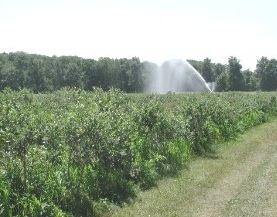
Equipment
Irrigating
Engineers devise new strategies for irrigating more efficiently
November 27, 2008 By Marg Land
 NEWS HIGHLIGHT
NEWS HIGHLIGHT
Engineers devise new strategies for irrigating more efficiently
To help reduce the vast amount of water used for agriculture which
consumes about four times the fresh water of homes and businesses –
researchers at University of California, San Diego’s Jacobs School are
using sensor technologies to devise new strategies for irrigating
farmland more efficiently.
Lack of clean water is responsible for more deaths in the world than war. Water conservation, high-tech irrigation strategies, desalination for increasing drinking water supplies, and large-scale recycling of wastewater and sewage are pieces of the clean-water-for-all puzzle that require engineering expertise and creativity.
 As world population continues to grow in the coming decades, freshwater supplies to farms, homes and businesses are expected to decline. To help reduce the vast amount of water used for agriculture – which consumes about four times the fresh water of homes and businesses – researchers at University of California, San Diego’s Jacobs School of Engineering are using sensor technologies to devise new strategies for irrigating farmland more efficiently.
As world population continues to grow in the coming decades, freshwater supplies to farms, homes and businesses are expected to decline. To help reduce the vast amount of water used for agriculture – which consumes about four times the fresh water of homes and businesses – researchers at University of California, San Diego’s Jacobs School of Engineering are using sensor technologies to devise new strategies for irrigating farmland more efficiently.
In alfalfa fields in California’s Imperial Valley, mechanical and aerospace engineering professor Jan Kleissl and his students have installed a “large aperture scintillometer” that measures, over a three-mile radius, the amount of irrigation water that is lost through evaporation from the ground and from plants. This evaporation data provides insights into how much irrigation water is needed.
The goal of the project is to create tools that California farmers and water agencies can use to determine exactly how much irrigation water a particular field requires, and thus avoid both overwatering and under watering.
Print this page